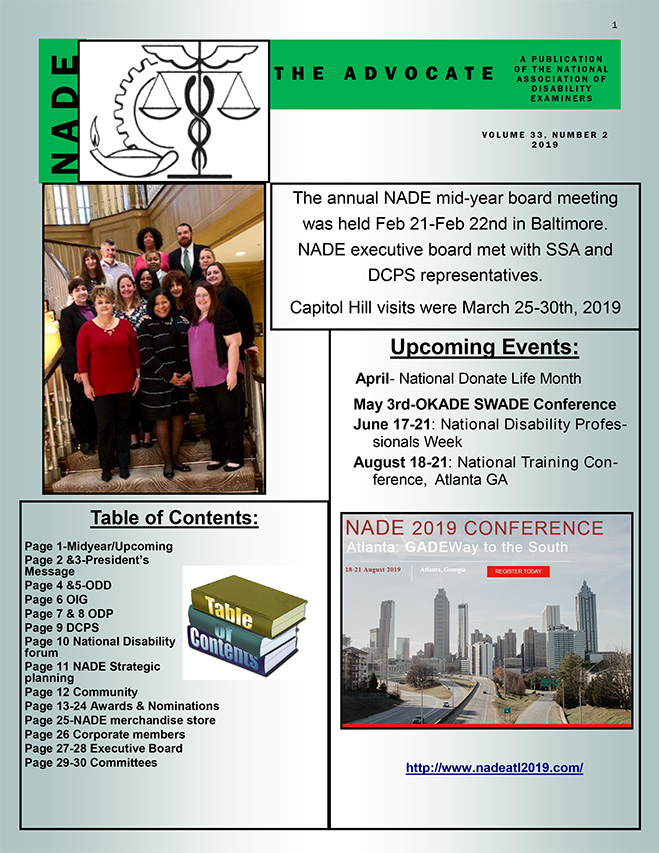Scott Horsley at National Public Radio is looking for stories of people who have gone back to work after being on Social Security disability benefits. He thinks that an increasing number are going back to work. I don't think that's accurate.
Apr 6, 2019
Apr 5, 2019
Nuggets From NADE Newsletter
The National Association of Disability Examiners (NADE), an organization for personnel who make initial and reconsideration determinations for Social Security, has posted its Spring 2019 newsletter. Here's a nugget from a summary of a meeting with Jim Julian, Social Security's Deputy Associate Commissioner for the Office of Disability Policy:
... Disability Modernization: This is an initiative to update our vocational regulations to reflect changes in medical and vocational practice, technology, and the work force.
SSA [Social Security Administration] is in the early stages of studying cases to learn the impact of potential Vocational Rules Modernization (VRM) policy updates.
The agency will use this information to develop and publish a notice of proposed rulemaking. ...And here's a nugget from a write-up of a meeting with Grace Kim, Acting Deputy Commissioner of Operations and John Owen, Associate Commissioner for the Office of Disability Determinations:
A tool being developed for disability adjudicators in the DDS [Disability Determination Services] and currently being piloted in the Iowa DDS is the IMAGEN (Intelligent Medical-Language Analysis GENeration) tool. IMAGINE is a tool to visualize, alert, summarize, search and more easily identify relevant clinical content in medical records. IMAGEN provides decisional guidance and enables disability adjudicators to leverage various machine learning technologies and predictive analytics to support data driven decisions.This program will eventually incorporate other Artificial Intelligence (AI) functions and have the ability to learn new information, adapt and evolve.
Labels:
Grid Regulations,
Information Technology,
NADE,
Newsletters
Apr 4, 2019
FY 2018 Waterfall Chart
Here's the fiscal year 2018 "waterfall chart" showing the outcomes of Social Security disability claims:
 |
| Click on image to view full size |
Note all the Administrative Law Judge dismissals. I expect most of this is related to how difficult it is to win. Attorneys who represent Social Security disability claimants don't take the case of everyone who seeks their help. We only work with those we deem to have a reasonable chance. If you're a claimant and you call several attorneys seeking representation and they all turn you away, what are you going to do? Probably you won't show up for your hearing and your case will get dismissed. Attorneys are, to some extent, gatekeepers. It's a role I'm uncomfortable with but there's no other way to make a living representing Social Security disability claimants in such a harsh environment.
Labels:
Disability Claims,
Statistics
Apr 3, 2019
Accidental Or Intentional?
I check in each month to see the number and total amount of fees that Social Security paid the prior month. Social Security has been posting that data for many years. Now, that website is gone with no explanation. It's not just that. Social Security had posted contact information for its payment centers. That website is gone as well.
This could be the result of some reorganization in Social Security's web presence but it would have to be a clumsy reorganization. There should be links to new URLs. There's no sign that I can find that these have been moved to new locations. They've just disappeared.
Have other useful parts of Social Security's web presence disappeared? Does anyone know what's going on? If these have been removed intentionally, I'd have to call it a rather petty act.
Labels:
Attorney Fees
Acting Commissioner's Budget
The President has submitted to Congress his proposed budget for Fiscal Year (FY) 2020 but since the Social Security Administration became an independent agency the Social Security Commissioner has been required to submit his or her own proposed budget for the agency. I'm almost surprised that the Acting Commissioner could work up the gumption to request anything beyond what the President has proposed but she has. Buried at the very end of the President's budget is the Acting Commissioner's proposed budget. She proposes $13.48 billion, about half a billion more than the President requested.
Of course, by the time there is any serious consideration of Social Security's operating budget, there may be a confirmed Commissioner whose opinions might be of some modest consequence.
Labels:
Budget,
Commissioner
Apr 2, 2019
The 6th Circuit Has Spoken So Let's Put These Claimants Back On Benefits
From WLEX:
My prediction is that Social Security will stall, saying they need more time to consider whether to ask the Supreme Court to hear the case. Ultimately, they won't ask for Supreme Court review because there is no clear reason why the Supreme Court would hear the case but the agency can delay resumption of benefits for these claimants for several months this way. No one at Social Security wants to be responsible for pulling the plug on their Eric Conn debacle. They'll want to let it wait until there's a confirmed Commissioner.
... On Sunday, attorneys filed a pleading in Federal Court seeking class action relief for the more than 800 former clients who lost their Social Security benefits as a result of the largest fraud case in the history of the agency.
The move comes after the U.S. 6th Circuit Court of Appeals denied the agency’s request for a rehearing of a November decision.
That decision found the Social Security Administration’s actions were unconstitutional when it tossed all medical records from four doctors associated with Conn’s scheme. As a result, hundreds of former clients lost their benefits.
“We’re hoping that, as of Friday, the Social Security Administration will acknowledge these hearings were unconstitutional and restore the benefits of 800 to 900 people up here,” said Ned Pillersdorf, an attorney who has represented former clients of Conn’s. ...It's not completely clear from this article but the class action relief sought at the moment is for the claimants involved to be placed back in payment status.
My prediction is that Social Security will stall, saying they need more time to consider whether to ask the Supreme Court to hear the case. Ultimately, they won't ask for Supreme Court review because there is no clear reason why the Supreme Court would hear the case but the agency can delay resumption of benefits for these claimants for several months this way. No one at Social Security wants to be responsible for pulling the plug on their Eric Conn debacle. They'll want to let it wait until there's a confirmed Commissioner.
Labels:
Appellate Decisions,
Eric Conn
OHO Backlog Coming Down
Below is the monthly Caseload Analysis Report for Social Security's Office of Hearings Operations (OHO) for the month ending February 22, 2019. It was obtained by the National Organization of Social Security Claimants Representatives (NOSSCR) and published in their newsletter, which is not available online to non-members. Click on the image to view full size.
Note in the far right hand column the number of receipts daily per available ALJ for the first six months of fiscal year 2019 -- 1.50. Note a bit further down in that column the ALJ dispositions daily per available ALJ -- 2.22. That means that each month OHO is processing about one and one-half months work. You can actually see that number further down the column as the DISP/REC Ratio -- 1.49. We started out with horribly high backlogs and we still have an unacceptably high backlog but while it's taking time the backlog is coming down rapidly.
By the way, note the amount of overtime hours at OHO. Something tells me that number is going to go down as the backlog goes down. The field offices, teleservice centers and payment centers need help but giving them OHO's overtime won't be much more than a drop in the bucket of their needs.
Labels:
Backlogs,
NOSSCR,
Statistics
Apr 1, 2019
SCOTUS Rules On Biestek
The Supreme Court has issued an opinion in Biestek v. Berryhill, a Social Security case. Here's an excerpt from the Supreme Court's syllabus of its opinion:
... Biestek proposes a categorical rule that the testimony of a vocational expert who refuses a request for supporting data about job availability can never clear that bar. To assess that proposal, the Court begins with the parties’ common ground: Assuming no demand, a vocational expert’s testimony may count as substantial evidence even when unaccompanied by supporting data.
If that is true, is it not obvious why one additional fact—a refusal to a request for that data—should make an expert’s testimony categorically inadequate. In some cases, the refusal to disclose data, considered along with other shortcomings, will undercut an expert’s credibility and prevent a court from finding that “a reasonable mind”could accept the expert’s testimony. But in other cases, the refusal will have no such consequence. Similarly, the refusal will sometimes interfere with effective cross-examination, which a reviewing court may consider in deciding how much to credit an expert’s opinion. But other times, even without supporting data, an applicant will be able to probe the strength of the expert’s testimony on cross-examination.Ultimately, Biestek’s error lies in his pressing for a categorical rule, applying to every case in which a vocational expert refuses a request for underlying data. The inquiry, as is usually true in determining the substantiality of evidence, is case-by-case. It takes into account all features of the vocational expert’s testimony, as well as the rest of the administrative record, and defers to the presiding ALJ, who has seen the hearing up close.By the way, here's an excerpt from the dissent of Justice Gorsuch, joined by Justice Ginsburg:
... Veteran Social Security practitioners must be feeling a sense of déjà vu. Half a century ago, Judge Henry Friendly encountered Kerner v. Flemming, 283 F. 2d 916 (CA2 1960). There, the agency’s hearing examiner offered “nothing save [his own] speculation” to support his holding that the claimant “could in fact obtain substantial gainful employment.” Id., at 921. The Second Circuit firmly explained that this kind of conclusory claim is insufficient to meet the substantial evidence standard. In response,the Social Security Administration began hiring vocational experts, like the one in this case, to document the number of jobs available to a given claimant. But if the government can do what it did in this case, it’s hard to see what all the trouble was for. The agency might still rest decisions on a hunch—just so long as the hunch comes from an agency contractor rather than an agency examiner. ...Justice Sotomayor also dissented separately but mostly agreed with Justice Gorsuch. It sound odd for Gorsuch, Ginsburg and Sotomayor to be on the same side but Social Security cases don't fall easily into some simple liberal-conservative dichotomy.
Labels:
Supreme Court,
Vocational Experts
Subscribe to:
Comments (Atom)


